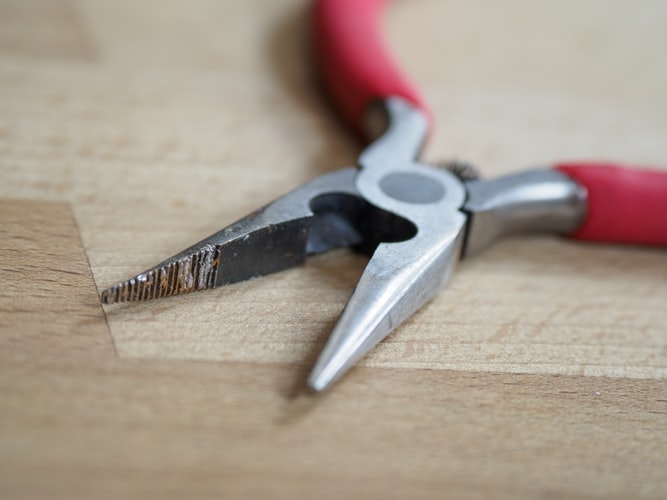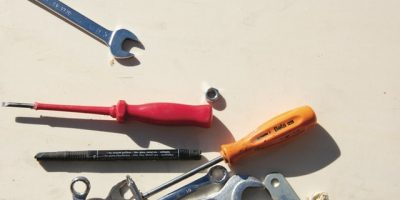Pliers are essential tools in a handyman’s arsenal. It comes in basic design and functionality that is a carry-over from medieval design. If you look at every basic toolset, it will always include pliers. Various types of pliers can confuse and intimidate users. It is crucial to know the difference between needle nose pliers vs long nose pliers because these two types are the most used tools. This article will extensively discuss everything about pliers and its functions
Parts of Pliers– needle nose pliers vs long nose

Needle nose pliers vs long nose will have similar parts. Each part will have a specific function to complete every task.
Cutters
Cutters are located near to the fulcrum and are used for breaking down wire and cable.
Fulcrum
The fulcrum is the part where the handles and the joint are fastened. It also functions to deliver enough force so the jaws can perform their job.
Handles
Handles are the parts which you grip. These parts can either be straight or curved. The coating will either be bare metal or plastic.
Jaws
The jaw is otherwise known as the nose, and it is the working end of pliers which functions as a grip. Combination pliers will have jaws which also have a cutter and pipe grip attachment.
Pipe Grips
This part is the rounded opening. Pipe grips were made to do as the name implies. They are extremely useful for gripping circular objects.
Types of Pliers- needle nose pliers vs long nose

Pliers come in three extensive categories, which are based on their function.
Cutting
Cutting pliers are a category which are utilized for cutting. It can only be used to cut the wire and other metal materials such as bolt and nails.
Holding
Pliers that fall under this category have no cutting ability and can only be used to grip objects of various thicknesses. Well-known models include groove joints, slip-joint, as well as locking pliers.
Multi-functional
These plier’s jaw configurations are used to perform both cutting and holding. Popular types under this category include the linesman long, and bent nose pliers
Multi-functional pliers- needle nose pliers vs long nose
Combination pliers
As the name suggests, these are essentials for those who do electrical jobs. Because these pliers will have multifunctionality, they are often the most popular pliers on the market and can be seen in any professional or DIY toolbox.
The nose of the pliers can be used for grabbing, as well as pulling, bending, and straightening materials, as well as twisting wires. A feature that is not often used are the outside edges, which can be used to remove the end of a conduit piece.
Combination pliers can be utilized to grip round objects such as nuts and bolts. The double cutter function close to the joint is suitable for cutting wires and threaded bolts.
Diagonal-cutting pliers
This type of pliers is designed to cut piano wires and other medium and soft wires as well as screws and nails up to 5 mm thick. They are not suitable for holding objects. Because this design is quite popular for electrical jobs, many brands manufactured versions with insulated handles to provide safety against electric shock.
Longnose pliers
Needle nose pliers vs long nose are interchangeable and are similar in functionality to linesman type pliers. It has the advantage of giving the user the ability to reach into difficult nooks and crannies due to the long and tapered design. Depending on the model, needle nose pliers vs long nose may come with various jaw configurations that allow them to perform different tasks.
Groove – joint pliers
These pliers are not considered as a precision tool. However, this type is still essential in every handyman’s arsenal. It provides a firm grip on objects with various sizes since it features two jaws joined by a pivot which slides into a slot.
The prevalent design feature is the set of curved teethed jaws. In some instances, the slot might be grooved to allow the jaws to be positioned widths apart, or have a smooth surface to give the jaw a way to adjust to the object’s size quickly.
Water pump pliers are utilized to grip objects of various sizes as well as bend wires. Sizes usually come between 8 inches and 20 inches in length. Another design of joint pliers are the smooth jaws that stop damage to the object being worked on. These pliers are widely used in the aerospace trade and in every area, which requires handling soft materials like plastics.
End-cutting pliers
These pliers are also called nippers and are utilized in cutting nails, wires, rivets, as well as bolts. Because of its flat design, workers can get near to the surface to cut the objects without having to dig into it. The most well-known sizes are 7 inches and 8 inches. A rivet fastens the jaws. Some designs come with longer handles for improved leverage and access.
Locking pliers
As the name suggests, these pliers will fasten on to the piece to be worked on for improved stability. To use this, adjust the distance between the two jaws following the material’s size to be gripped. Afterward, clamp the handles together to lock the work in place.
Other specialized pliers are also available such as crimping pliers. Fencing pliers and other higher leverage spring-loaded designs give the ability to open and close handles effortlessly.
Pliers Construction- needle nose pliers vs long nose

There isn’t much elevation or change to supplier construction since the middle ages. As it was back then, it will consist of three main parts.
Jaws
Jaws will come in various patterns and designs that provide unique functionality to the tool. It can cut, pull, hold, and strip.
The jaw’s tip can be flat or half-round or completely rounded, such as electronic pliers. It provides functionality for bending, holding, and gripping different types of material.
The cutter is made to cut through a wire of varying thicknesses, and metal materials such as bolts and nails
pivot point
The pivot point fastens the jaw and handles together. The pivot point gives the jaw more leverage and cutting ability than regular pliers will have.
Handles
Handles allow the operator to get a good grip on the pliers. There are various materials used to coat the handles, which give varying levels of comfort. A common material used is vinyl. Other materials are also used to insulate the handle and protect users against electric shock.
How to Choose Pliers- needle nose pliers vs long nose
The initial consideration when selecting your next set of pliers is determining the application you require of them. Different plier types will have varying degrees of versatility and flexibility. Some designs even have multiple functions, while others do more specialized tasks.
Once you decide on one type, do your research. Read up as much as you can about the competing brands on the market. Research videos reviews and ask experts on what kind of pliers they prefer. It is also crucial to test different brands and see which one matches your needs. What is needle nose pliers vs long nose? Pliers come in different surface finishes, comfort, weight, and ease of handling. They will also perform differently from each other. In the end, it is your personal preference in style and ergonomics that will make the final decision.
The price will also play a crucial role in your choice of pliers. Pliers are prevalent in every toolbox, so get the best pliers for your budget. Although a lot of brands give a lifetime warranty, in the end, professionals will not be satisfied with pliers that don’t perform well or get dulled and break easily. Even if there is a warranty, they will have to spend time returning it, which leads to lost productivity.
Safety Measures When Using Pliers– needle nose pliers vs long nose
What is needle nose pliers vs long nose? Opt for the best pliers for the task. What is needle nose pliers vs long nose? Give yourself time to research the different pliers and their important features such as cutting ability and the type of wires they can cut. What is needle nose pliers vs long nose? If you fail to know the facts, it can result in early wear and tear of the tool, damage to the jaw, and an inability to perform the job efficiently, resulting in accidents.
What is needle nose pliers vs long nose? Pliers that come with insulated handles are suitable when working with live wires. Handles that are not insulated can easily be confused with insulated types. Insulated handles will be marked with a double triangle symbol or special logo.
cuts
Make sure that you are cutting at a right angle for a cleaner and more effective cut. Use a larger sized tool or model with a greater cutting capability on difficult tasks.
gear
Wear protective gear such as safety glasses when you use pliers with pieces that can fly off unexpectedly.
size
Use pliers with a size appropriate for your grip and individual comfort. If you use too small pliers, they can pinch your hands and fingers, whereas a size that is too big can cause a tool to be dropped or an inability to use them at all.
right use
Never use your pliers as a hammer, nor should you use the pliers handles to strike and cut thicker wires and bolts.
cleaning
Regularly clean and maintain your pliers. Dropping oil on the jaws and the rivets will increase its lifespan.
Use a wrench
What is needle nose pliers vs long nose? Avoid using pliers for tightening or breaking. Instead, use the proper tool, which is a wrench, to avoid damaging the nuts.
heat
Never expose pliers to extreme heat since the tool’s materials might change.
condition
Examine the condition of the plier prior to using it. Use tools that are safe and functioning properly.
damage
Stop using damaged pliers and invest in a new set.
How are needle-nose pliers used? — needle nose pliers vs long nose
What is needle nose pliers vs long nose? Pliers are beneficial tools that are present in every home toolbox. Needle nose pliers have a distinct feature that distinguishes them from other types of pliers. They are long and narrow with pointed or curved angled tips and provide firm handling. What is needle nose pliers vs long nose? Steel is a common material used on needle nose pliers while the handles will be insulated plastic or rubber-coated making it effortless to grip. These materials also protect from electric shock. What is needle nose pliers vs long nose? Needle-nose pliers will have sharp thin blades that come in varying sizes. They are made to fit into nooks and crannies and tight spaces, which can’t be reached by hand. What is needle nose pliers vs long nose? Some types will also include a cutting tool at the tip for wires and electrical work.
What is needle nose pliers vs long nose?
Although needle-nose pliers are typically used to cut and bend smaller wires, and electric wires, needle nose pliers will have other functions. It can cut and grip material where fingers and other tools are too large or un-precise. When it comes to reaching into a tight spot where regular pliers are too clumsy, using needle-nose are ideal. What is needle nose pliers vs long nose? They can grip in more than one way and even pick up tiny screws with a strong and firm grip. Craftspeople use needle-nose pliers for intricate projects with tiny objects. It is used for making jewelry such as picking up metal pieces and joining beads as well as setting stones and fastening small clasps. What is needle nose pliers vs long nose? It is crucial to grip needle-nose pliers firmly as you exert gentle force. On the downside, these pliers are not strong enough for larger and tougher wires. They are not meant to be used with live electrical wires.
Final Thoughts
Needle-nose pliers and long nose pliers will have similar use. Both were intended for tasks involving electrical wires. What is needle nose pliers vs long nose? They provide flexibility to every toolbox. They can be extensively used in many settings such as electrical jobs, construction sites, handyman tasks and crafts. What is needle nose pliers vs long nose?
Both needle-nose pliers and long nose pliers are vital to your arsenal when doing maintenance jobs, repair jobs, and any task around the house.


